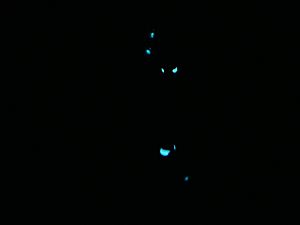Eyelight fish facts for kids
Quick facts for kids Eyelight fish |
|
|---|---|
| Conservation status | |
| Scientific classification | |
| Genus: |
Photoblepharon
|
| Species: |
palpebratum
|
| Synonyms | |
|
|
The eyelight fish (also called the one-fin flashlightfish) is a fascinating saltwater fish known for its special light-up organs. Its scientific name is Photoblepharon palpebratum. This small fish lives in the western and central Pacific Ocean. You can find it near coral reefs on the ocean floor, often hiding near rocks and corals.
Eyelight fish are only about 12.0 cm (4.7 in) long. They are mostly black, with shiny scales along their sides and a white spot near their gills. Their most amazing feature is the glowing organs under their eyes. These organs produce a blue-green light. The fish uses this light to find food, talk to other fish, and even confuse enemies. They can turn the light on and off using a dark lid that slides over the organs.
This fish is nocturnal, meaning it is active at night. During the day, it hides in caves and cracks in the rocks. At night, it comes out to hunt for food, often in large groups. Like other fish in its family, the eyelight fish lays eggs. Females can lay up to 1,000 eggs at a time near the water's surface. The eyelight fish is not often caught for food. It is sometimes used as bait by local fishermen. Because it is hard to find due to its nighttime habits, scientists don't have enough information about its population.
Contents
What's in a Name?
The eyelight fish got its first scientific name, Sparus palpebratus, in 1781 from a Dutch scientist named Pieter Boddaert. The word "sparus" is Latin for "a fish with a golden head."
Later, in 1902, another scientist named Max Carl Wilhelm Weber gave it the name "Photoblepharon." This name comes from Greek words: "photo" means "light," and "blepharon" means "eyelash" or "eye." This name perfectly describes its glowing eyes!
What Does the Eyelight Fish Look Like?
The eyelight fish is a small, dark fish with a sturdy body. It has a rounded snout and big eyes. Its most special features are the cream-colored light organs under its eyes.
Most of its body is black. But it has a clear white spot near its gills and a line of shiny scales along its side. It also has white scales near its front fins. At only 12.0 cm (4.7 in) long, it is one of the smaller fish in its family.
The light organs under its eyes glow with a blue-green light. This light comes from tiny bioluminescent bacteria living inside the organs. These bacteria get oxygen and food from the fish's blood. The fish can cover these organs with a black lid when it doesn't want to glow. This is a special way Photoblepharon fish turn off their lights. Other fish in its family might rotate their light organs or use a different method.
Where Do Eyelight Fish Live?
The eyelight fish lives across a wide area in the western and central Pacific Ocean. You can find it from the Philippines in the west all the way to the Society Islands in the east. It also lives south near New Caledonia.
Even though it was first thought to only live in Indonesia, it has been seen near Guam and caught near Australia, the Marshall Islands, the Caroline Islands, the Cook Islands, and Papua New Guinea. Because it's hard to spot due to its nighttime habits, scientists believe it might live in even more places!
This fish prefers to live near deep reefs with steep drop-offs and caves. It is usually found alone or in pairs. When it hunts, it stays close to the ocean floor. It likes water temperatures between 18 and 29 °C (64 and 84 °F). Divers usually see it no deeper than 15 m (49 ft), but it can live as deep as 50 m (160 ft) below the surface.
Eyelight Fish Life and Habits
The eyelight fish spends its days hiding in caves and cracks in the rocks. When night falls, it comes out to feed. It often hunts in large groups away from the reef. Its main food source is likely small crustaceans, which it might find or attract using its glowing light organs.
Reproduction and Life Cycle
Like other fish in its family, the eyelight fish reproduces by laying eggs. This is called being oviparous. Mated pairs release their eggs near the water's surface. A female fish can lay about 1,000 eggs each time she spawns.
These eggs float in the water for a short time. Then, they attach to a nearby surface. Within a day, the eggs turn milky white and sink to the bottom. Scientists have seen them spawn in April and May, but they likely lay eggs at other times of the year too.
The special bacteria that make the light in the fish's organs are unique. Some of these bacteria can leave the fish's organs and still be alive, but they stop glowing soon after.
Eyelight Fish and Humans
Humans don't interact much with the eyelight fish. It is harmless and spends its days hidden, so divers rarely see it.
This fish doesn't have much value for commercial fishing. Its main use is as bait for local fishermen. They sometimes cut out the light organs and attach them to hooks.
The International Union for the Conservation of Nature (IUCN) lists the eyelight fish as "Data Deficient." This means scientists don't have enough information about its population. Its nighttime habits make it hard to study and count, which is a big reason for this lack of data.
Images for kids




